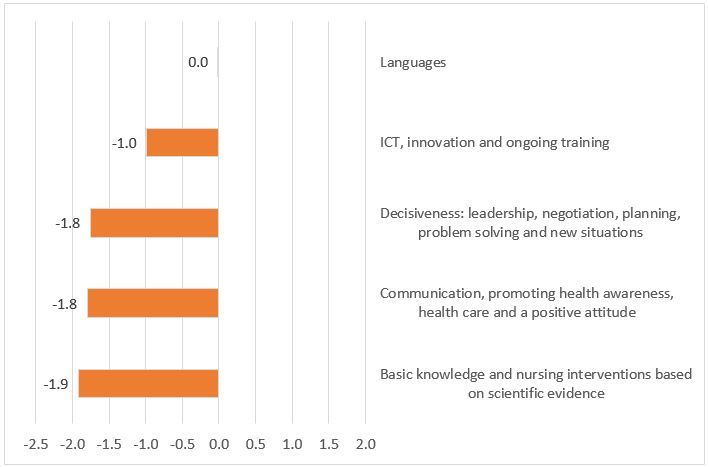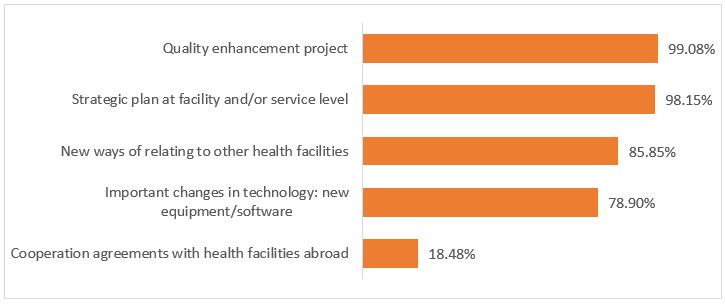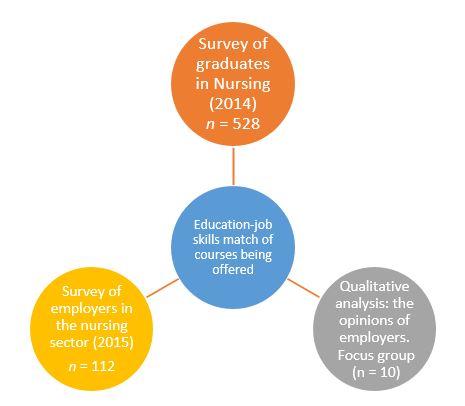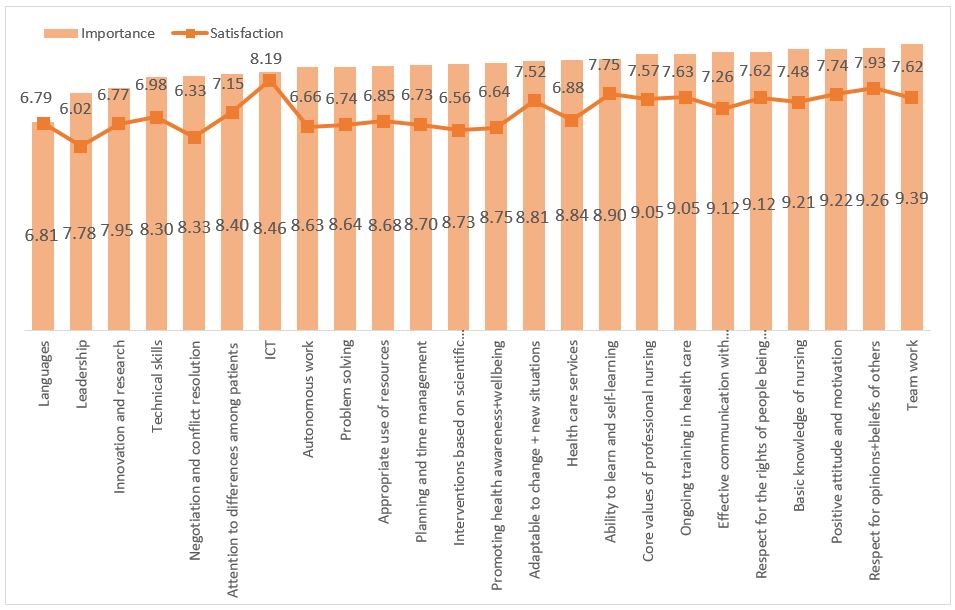82
July 2016
ARTICLES
The opinions of directors and supervisors of nursing on the Bachelor's degree in Nursing
Anna Prades - Project manager of Quality Assurance Department
The objective of the study on the opinions of employers in the nursing sector forms part of the Employers project 2013-2015, which is funded by support from Obra Social/la Caixa, is to gather the opinions of employers as to the skills and training of recent graduates in Catalonia.
The information made available through this project on the skills and competences of graduates in the system of universities and higher education in Catalonia, from the point of view of both graduates and employers, is the first of its type in Spain.
The opinions of employers in the nursing sector were compiled using a methodology that was both quantitative and qualitative. The diagram below represents the three information gathering mechanisms used for assessing the education-skills match and suitability of courses being offered in nursing as regards the requirements of the labour market.
Diagram 1. Recent studies and surveys, and the sample used, of the match between
courses in higher education institutions in Catalonia and labour market requirements
112 responses to the survey of employers in the nursing sector were received from directors and supervisors of nursing at health facilities in the Public Hospital Network (XHUP) and the Catalan Institute of Health (ICS). The survey was carried out on-line.
As the figures from the 2014 survey on the employment outcomes of graduates in Nursing show, there is a high employment rate (84%) for graduates in Nursing and a very good (close) education-job skills match (with 89% of graduates holding jobs for which their formal qualifications are suitable). In addition, 87% would take the same degree again if they were to start studying again.
The main findings of the study are described below:
- Recruitment of recent Nursing graduates
- Skills of recent Nursing graduates
- Learning challenges and necessary skills
- Orientation, training and innovation at health facilities
- Cooperation with universities
- For more information
Recruitment of recent Nursing graduates
A large majority of employers were satisfied with the training of Nursing graduates (85% of those in ICS units and 75% in Public Hospital Network units).
In general, it is not totally clear whether there has been a clear improvement with Bachelor’s degrees compared to pre-Bologna degrees (Diplomatura). On the other hand, the ratings for Master’s degrees were very high. This may be connected to the fact that 67% of employers in the Public Hospital Network (which are the only ones that can recruit) affirmed that they had had difficulties in recruiting new nursing staff, mainly because of the shortage of applicants with the specific required training (74%).
Diagram 2. Matching the profile of recently recruited Nursing graduates compared to graduates
of pre-Bologna degree courses (diplomatura) in Nursing (n = 72)
Skills of recent Nursing graduates
In order to be able to provide a service of quality, a combination of skills of a very different nature is required in nursing, the most important of which are teamwork, respect, attitude and knowledge and understanding.
The mean satisfaction of employers in the nursing sector was rated at 7.2, which was slightly higher than the mean satisfaction of employers in general (7) and that of educational institutions with new teachers (6.8).
Diagram 3. Comparison between the mean values for the importance of
and satisfaction with the skills of new nursing staff
Learning challenges and necessary skills
According to the study data, training facilities should prioritise learning activities that promote the ability for nursing interventions to be based on scientific evidence.
The same level of importance should be given to the core skills associated with healthcare, including the ability to communicate effectively, the promotion of health awareness and wellbeing, and skills that promote decisiveness at professional level.
Diagram 4. Room for skills improvement

There was no notable gap for the skills associated with on-going training and languages.
Orientation, training and innovation at health facilities
Almost all health facilities provided orientation for new nursing staff. The most common activities were internships prior to the start of a contract (60%) and mentoring (59%).
Health facilities are innovative. Practically all health facilities had projects for quality enhancement (99%) and a strategic plan at facility and/or service level (98%). The majority were innovative as regards new ways of relating to other health facilities (86%) and through the implementation of important changes in technology (79%).
Diagram 5. Innovative actions at facility and/or service level

Cooperation with universities
There is a strong tradition of cooperation between health facilities and universities, which resulted in higher levels for indicators of cooperation than in other types of organisation or institution, especially as regards internships (91% compared to 63%).
In addition, almost half of all employers in the nursing sector had participated in university-level training and/or assessing curricula, and more than 40% had participated in research projects.
For more information
ANA - AMERICAN NURSES ASSOCIATION (2010) Nursing: Scope and Standards of Practice (Second ed.). Silver Spring: Nursesbooks.org.
AGENCIA NACIONAL DE EVALUACIÓN DE LA CALIDAD Y ACREDITACIÓN (2004) Libro Blanco del Título de Grado en Enfermería. Madrid: ANECA. [DOI:10.1017/CBO9781107415324.004].
QUALITY ASSURANCE AGENCY FOR HIGHER EDUCATION (2009) Scottish subject benchmark statement Midwifery. Glasgow: QAA Scotland.









